Assessing the Volatility of Daily Maximum Temperature across Germany between 1990 and 2022
Abstract
:1. Introduction
2. Materials and Methods
2.1. Description of the Study Area
2.2. Data
2.2.1. E-OBS Daily Gridded Meteorological Data
2.2.2. CORINE Land Cover Data
2.3. Computation of Temperature Volatility
2.3.1. Calculation of Extreme Temperature Volatility
2.3.2. Seasonality, Directionality, and Timing of Extreme Temperature Volatility
2.3.3. Trend Analysis
2.3.4. Assessment of Land Use and Land Cover Change (LULCC)
3. Results
3.1. Temperature Volatility
3.2. Extreme Temperature Volatility
3.2.1. Magnitude and Seasonality
3.2.2. Directionality and Timing
3.3. Trends in Extreme Temperature Volatility
3.4. Impact of Land Use and Land Cover Change on Extreme Temperature Volatility
4. Discussion
4.1. Trends in Extreme Temperature Volatility
4.2. Impact of Land Use and Land Cover Changes on Extreme Temperature Volatility
5. Conclusions
Supplementary Materials
Author Contributions
Funding
Institutional Review Board Statement
Data Availability Statement
Acknowledgments
Conflicts of Interest
References
- IPCC. Climate Change 2021: The Physical Science Basis: Working Group I contribution to the Sixth Assessment Report of the Intergovernmental Panel on Climate Change; Cambridge University Press: Cambridge, UK; New York, NY, USA, 2021. [Google Scholar]
- IPCC. Climate Change 2023: Synthesis Report. A Report of the Intergovernmental Panel on Climate Change; Contribution of Working Groups I, II and III to the Sixth Assessment Report of the Intergovernmental Panel on Climate Core Writing Team, Lee, H., Romero, J., Eds.; IPCC: Geneva, Switzerland, 2023.
- Ombadi, M.; Risser, M.D. What’s the temperature tomorrow? Increasing trends in extreme volatility of daily maximum temperature in Central and Eastern United States (1950–2019). Weather Clim. Extrem. 2022, 38, 100515. [Google Scholar] [CrossRef]
- Lin, H.; Zhang, Y.; Xu, Y.; Xu, X.; Liu, T.; Luo, Y.; Xiao, J.; Wu, W.; Ma, W. Temperature changes between neighboring days and mortality in summer: A distributed lag non-linear time series analysis. PLoS ONE 2013, 8, e66403. [Google Scholar] [CrossRef] [PubMed]
- Hovdahl, I. The deadly effect of day-to-day temperature variation in the United States. Environ. Res. Lett. 2022, 17, 104031. [Google Scholar] [CrossRef]
- Guo, Y.; Barnett, A.G.; Yu, W.; Pan, X.; Ye, X.; Huang, C.; Tong, S. A large change in temperature between neighbouring days increases the risk of mortality. PLoS ONE 2011, 6, e16511. [Google Scholar] [CrossRef]
- Cheng, J.; Zhu, R.; Xu, Z.; Xu, X.; Wang, X.; Li, K.; Su, H. Temperature variation between neighboring days and mortality: A distributed lag non-linear analysis. Int. J. Public Health 2014, 59, 923–931. [Google Scholar] [CrossRef] [PubMed]
- Kotz, M.; Wenz, L.; Stechemesser, A.; Kalkuhl, M.; Levermann, A. Day-to-day temperature variability reduces economic growth. Nat. Clim. Chang. 2021, 11, 319–325. [Google Scholar] [CrossRef]
- Badeck, F.W.; Bondeau, A.; Böttcher, K.; Doktor, D.; Lucht, W.; Schaber, J.; Sitch, S. Responses of spring phenology to climate change. New Phytol. 2004, 162, 295–309. [Google Scholar] [CrossRef]
- Jeong, S.-J.; Ho, C.-H.; Gim, H.-J.; Brown, M.E. Phenology shifts at start vs. end of growing season in temperate vegetation over the Northern Hemisphere for the period 1982–2008. Glob. Chang. Biol. 2011, 17, 2385–2399. [Google Scholar] [CrossRef]
- Estrella, N.; Menzel, A. Responses of leaf colouring in four deciduous tree species to climate and weather in Germany. Clim. Res. 2006, 32, 253–267. [Google Scholar] [CrossRef]
- Doi, H.; Takahashi, M. Latitudinal patterns in the phenological responses of leaf colouring and leaf fall to climate change in Japan. Glob. Ecol. Biogeogr. 2008, 17, 556–561. [Google Scholar] [CrossRef]
- Delpierre, N.; Dufrêne, E.; Soudani, K.; Ulrich, E.; Cecchini, S.; Boé, J.; François, C. Modelling interannual and spatial variability of leaf senescence for three deciduous tree species in France. Agric. For. Meteorol. 2009, 149, 938–948. [Google Scholar] [CrossRef]
- Wang, X.; Wu, G.; Qin, Y. Day-to-Day Temperature Variability in China During Last 60 Years Relative to Arctic Oscillation. Earth Space Sci. 2022, 9, e2022EA002587. [Google Scholar] [CrossRef]
- Rebetez, M. Changes in daily and nightly day-to-day temperature variability during the twentieth century for two stations in Switzerland. Theor. Appl. Climatol. 2001, 69, 13–21. [Google Scholar] [CrossRef]
- Moberg, A.; Jones, P.D.; Barriendos, M.; Bergström, H.; Camuffo, D.; Cocheo, C.; Davies, T.D.; Demarée, G.; Martin-Vide, J.; Maugeri, M.; et al. Day-to-day temperature variability trends in 160- to 275-year-long European instrumental records. JGR Atmos. 2000, 105, 22849–22868. [Google Scholar] [CrossRef]
- IPCC. Climate Change and Land: An IPCC Special Report on Climate Change, Desertification, Land Degradation, Sustainable Land Management, Food Security, and Greenhouse Gas Fluxes in Terrestrial Ecosystems; IPCC: Cambridge, UK, 2019.
- Zhang, F.; Tiyip, T.; Kung, H.; Johnson, V.C.; Maimaitiyiming, M.; Zhou, M.; Wang, J. Dynamics of land surface temperature (LST) in response to land use and land cover (LULC) changes in the Weigan and Kuqa river oasis, Xinjiang, China. Arab. J. Geosci. 2016, 9, 499. [Google Scholar] [CrossRef]
- Merga, B.B.; Moisa, M.B.; Negash, D.A.; Ahmed, Z.; Gemeda, D.O. Land Surface Temperature Variation in Response to Land-Use and Land-Cover Dynamics: A Case of Didessa River Sub-basin in Western Ethiopia. Earth Syst. Environ. 2022, 6, 803–815. [Google Scholar] [CrossRef]
- DWD. Nationaler Klimareport; DWD: Offenbach, Germany, 2022. [Google Scholar]
- Federal Statistical Office of Germany. Land- und Forstwirtschaft, Fischerei: Bodenflächen nach Art der Tatsächlichen Nutzung; Reihe 5.1; Federal Statistical Office of Germany: Wiesbaden, Germany, 2022.
- van der Schrier, G.; van den Besselaar, E.J.M.; Klein Tank, A.M.G.; Verver, G. Monitoring European average temperature based on the E-OBS gridded data set. JGR Atmos. 2013, 118, 5120–5135. [Google Scholar] [CrossRef]
- Haylock, M.R.; Hofstra, N.; Klein Tank, A.M.G.; Klok, E.J.; Jones, P.D.; New, M. A European daily high-resolution gridded data set of surface temperature and precipitation for 1950–2006. JGR Atmos. 2008, 113. [Google Scholar] [CrossRef]
- Cornes, R.C.; van der Schrier, G.; van den Besselaar, E.J.M.; Jones, P.D. An Ensemble Version of the E-OBS Temperature and Precipitation Data Sets. JGR Atmos. 2018, 123, 9391–9409. [Google Scholar] [CrossRef]
- Cornes, R.C.; Jones, P.D. How well does the ERA-Interim reanalysis replicate trends in extremes of surface temperature across Europe? JGR Atmos. 2013, 118. [Google Scholar] [CrossRef]
- Copernicus Climate Change Service. E-OBS Daily Gridded Meteorological Data for Europe from 1950 to Present Derived from In-Situ Observations; ECMWF: Reading, UK, 2020. [Google Scholar]
- Copernicus Land Monitoring Service. CORINE Land Cover. Available online: https://land.copernicus.eu/pan-european/corine-land-cover (accessed on 9 June 2023).
- European Environment Agency. CORINE Land Cover 2018 (Raster 100 m), Europe, 6-Yearly—Version 2020_20u1, May 2020. 2019. Available online: https://land.copernicus.eu/en/products/corine-land-cover/clc2018 (accessed on 9 June 2023).
- European Environment Agency. CORINE Land Cover 1990 (Raster 100 m), Europe, 6-Yearly—Version 2020_20u1, May 2020. 2019. Available online: https://land.copernicus.eu/en/products/corine-land-cover/clc1990 (accessed on 9 June 2023).
- Hijmans, R. terra: Spatial Data Analysis, R Package Version 1.7-80. 2023. Available online: https://CRAN.R-project.org/package=terra (accessed on 11 July 2024).
- Hijmans, R. raster: Geographic Data Analysis and Modeling, R Package Version 3.6-20. 2023. Available online: https://CRAN.R-project.org/package=raster (accessed on 11 July 2024).
- Kosztra, B.; Büttner, G.; Hazeu, G.; Arnold, S. Updated CLC Illustration Nomenclature Guidelines. Available online: https://land.copernicus.eu/user-corner/technical-library/corine-land-cover-nomenclature-guidelines/docs/pdf/CLC2018_Nomenclature_illustrated_guide_20190510.pdf (accessed on 9 June 2023).
- Miller, J.; Miller, J.C. Statistics and Chemometrics for Analytical Chemistry, 6th ed.; Pearson Education Ltd.: Essex, UK, 2014; ISBN 978-0-273-73042-2. [Google Scholar]
- Hamed, K.H. Exact distribution of the Mann–Kendall trend test statistic for persistent data. J. Hydrol. 2009, 365, 86–94. [Google Scholar] [CrossRef]
- Kendall, M.G.; Gibbons, J.D. Rank Correlation Methods; Arnold: London, UK, 1990. [Google Scholar]
- Mann, H.B. Nonparametric Tests Against Trend. Econometrica 1945, 13, 245. [Google Scholar] [CrossRef]
- Kong, D.; Song, H. rtrend: Trend Estimating Tools, R Package Version 0.1.4. 2022. Available online: https://cran.r-project.org/web/packages/rtrend/rtrend.pdf (accessed on 9 April 2023).
- Wilks, D.S. “The Stippling Shows Statistically Significant Grid Points”: How Research Results are Routinely Overstated and Overinterpreted, and What to Do about It. Bull. Am. Meteorol. Soc. 2016, 97, 2263–2273. [Google Scholar] [CrossRef]
- Wickham, H.; François, R.; Henry, L.; Müller, K.; Vaughan, D. dplyr: A Grammar of Data Manipulation. 2023. Available online: https://dplyr.tidyverse.org (accessed on 11 July 2024).
- Grolemund, G.; Wickham, H. Dates and Times Made Easy with lubridate. J. Stat. Soft. 2011, 40. [Google Scholar] [CrossRef]
- Wickham, H. Ggplot2: Elegrant Graphics for Data Analysis, 2nd ed.; Springer: Cham, Switzerland, 2016. [Google Scholar]
- ESRI Data and Maps. World Countries Generalized. Available online: https://hub.arcgis.com/datasets/esri::world-countries-generalized/about (accessed on 11 July 2024).
- Marqués, L.; Hufkens, K.; Bigler, C.; Crowther, T.W.; Zohner, C.M.; Stocker, B.D. Acclimation of phenology relieves leaf longevity constraints in deciduous forests. Nat. Ecol. Evol. 2023, 7, 198–204. [Google Scholar] [CrossRef] [PubMed]
- Peñuelas, J.; Rutishauser, T.; Filella, I. Ecology. Phenology feedbacks on climate change. Science 2009, 324, 887–888. [Google Scholar] [CrossRef]
- Sun, M.; Li, P.; Ren, P.; Tang, J.; Zhang, C.; Zhou, X.; Peng, C. Divergent response of vegetation phenology to extreme temperatures and precipitation of different intensities on the Tibetan Plateau. Sci. China Earth Sci. 2023, 66, 2200–2210. [Google Scholar] [CrossRef]
- Ren, P.; Liu, Z.; Zhou, X.; Peng, C.; Xiao, J.; Wang, S.; Li, X.; Li, P. Strong controls of daily minimum temperature on the autumn photosynthetic phenology of subtropical vegetation in China. For. Ecosyst. 2021, 8, 31. [Google Scholar] [CrossRef]
- Li, C.; Zou, Y.; He, J.; Zhang, W.; Gao, L.; Zhuang, D. Response of Vegetation Phenology to the Interaction of Temperature and Precipitation Changes in Qilian Mountains. Remote Sens. 2022, 14, 1248. [Google Scholar] [CrossRef]
- Zohner, C.M.; Mo, L.; Renner, S.S.; Svenning, J.-C.; Vitasse, Y.; Benito, B.M.; Ordonez, A.; Baumgarten, F.; Bastin, J.-F.; Sebald, V.; et al. Late-spring frost risk between 1959 and 2017 decreased in North America but increased in Europe and Asia. Proc. Natl. Acad. Sci. USA 2020, 117, 12192–12200. [Google Scholar] [CrossRef]
- Vitra, A.; Lenz, A.; Vitasse, Y. Frost hardening and dehardening potential in temperate trees from winter to budburst. New Phytol. 2017, 216, 113–123. [Google Scholar] [CrossRef] [PubMed]
- Waldau, T.; Chmielewski, F.-M. Spatial and temporal changes of spring temperature, thermal growing season and spring phenology in Germany 1951–2015. metz 2018, 27, 335–342. [Google Scholar] [CrossRef]
- Rapp, J. Regionale Klimatrends in Deutschland im 20. Jahrhundert. In Klimastatusbericht 2001; DWD: Offenbach, Germany, 2002. [Google Scholar]
- Jaagus, J.; Briede, A.; Rimkus, E.; Remm, K. Variability and trends in daily minimum and maximum temperatures and in the diurnal temperature range in Lithuania, Latvia and Estonia in 1951–2010. Theor. Appl. Climatol. 2014, 118, 57–68. [Google Scholar] [CrossRef]
- Jones, R.N.; Ricketts, J.H. Regime Changes in Atmospheric Moisture under Climate Change. Atmosphere 2022, 13, 1577. [Google Scholar] [CrossRef]
- Seneviratne, S.I.; Zhang, X.; Adnan, M.; Badi, W.; Dereczynski, C.; Di Luca, A.; Ghosh, S.; Iskandar, I.; Kossin, J.; Lewis, S.; et al. Weather and Climate. In Climate Change 2021—The Physical Science Basis: Contribution of Working Group I to the Sixth Assessment Report of the Intergovernmental Panel on Climate; Masson-Delmotte, V., Zhai, P., Pirani, A., Connors, S.L., Péan, C., Berger, S., Caud, N., Chen, Y., Goldfarb, L., Gomis, M.I., et al., Eds.; Cambridge University Press: Cambridge, UK; New York, NY, USA, 2021; pp. 1513–1766. [Google Scholar]
- Feddema, J.J.; Oleson, K.W.; Bonan, G.B.; Mearns, L.O.; Buja, L.E.; Meehl, G.A.; Washington, W.M. The importance of land-cover change in simulating future climates. Science 2005, 310, 1674–1678. [Google Scholar] [CrossRef]
- Duveiller, G.; Hooker, J.; Cescatti, A. The mark of vegetation change on Earth’s surface energy balance. Nat. Commun. 2018, 9, 679. [Google Scholar] [CrossRef]
- Schwaab, J.; Davin, E.L.; Bebi, P.; Duguay-Tetzlaff, A.; Waser, L.T.; Haeni, M.; Meier, R. Increasing the broad-leaved tree fraction in European forests mitigates hot temperature extremes. Sci. Rep. 2020, 10, 14153. [Google Scholar] [CrossRef] [PubMed]
- Lawrence, D.; Coe, M.; Walker, W.; Verchot, L.; Vandecar, K. The Unseen Effects of Deforestation: Biophysical Effects on Climate. Front. For. Glob. Chang. 2022, 5, 756115. [Google Scholar] [CrossRef]
- Schultz, N.M.; Lawrence, P.J.; Lee, X. Global satellite data highlights the diurnal asymmetry of the surface temperature response to deforestation. JGR Biogeosci. 2017, 122, 903–917. [Google Scholar] [CrossRef]
- Li, Y.; Zhao, M.; Motesharrei, S.; Mu, Q.; Kalnay, E.; Li, S. Local cooling and warming effects of forests based on satellite observations. Nat. Commun. 2015, 6, 6603. [Google Scholar] [CrossRef]
- Davin, E.L.; de Noblet-Ducoudré, N. Climatic Impact of Global-Scale Deforestation: Radiative versus Nonradiative Processes. J. Clim. 2010, 23, 97–112. [Google Scholar] [CrossRef]
- Pongratz, J.; Schwingshackl, C.; Bultan, S.; Obermeier, W.; Havermann, F.; Guo, S. Land Use Effects on Climate: Current State, Recent Progress, and Emerging Topics. Curr. Clim. Chang. Rep. 2021, 7, 99–120. [Google Scholar] [CrossRef]
- Lejeune, Q.; Davin, E.L.; Gudmundsson, L.; Winckler, J.; Seneviratne, S.I. Historical deforestation locally increased the intensity of hot days in northern mid-latitudes. Nat. Clim. Chang. 2018, 8, 386–390. [Google Scholar] [CrossRef]
- Findell, K.L.; Berg, A.; Gentine, P.; Krasting, J.P.; Lintner, B.R.; Malyshev, S.; Santanello, J.A.; Shevliakova, E. The impact of anthropogenic land use and land cover change on regional climate extremes. Nat. Commun. 2017, 8, 989. [Google Scholar] [CrossRef] [PubMed]
- Winckler, J.; Reick, C.H.; Luyssaert, S.; Cescatti, A.; Stoy, P.C.; Lejeune, Q.; Raddatz, T.; Chlond, A.; Heidkamp, M.; Pongratz, J. Different response of surface temperature and air temperature to deforestation in climate models. Earth Syst. Dynam. 2019, 10, 473–484. [Google Scholar] [CrossRef]
- Alkama, R.; Cescatti, A. Biophysical climate impacts of recent changes in global forest cover. Science 2016, 351, 600–604. [Google Scholar] [CrossRef]
- Martin, T.; Brown, K.; Kučera, J.; Meinzer, F.; Sprugel, D.; Hinckley, T. Control of transpiration in a 220-year-old Abies amabilis forest. For. Ecol. Manag. 2001, 152, 211–224. [Google Scholar] [CrossRef]
- Brantley, S.T.; Miniat, C.F.; Bolstad, P.V. Rainfall partitioning varies across a forest age chronosequence in the southern Appalachian Mountains. Ecohydrology 2019, 12, e2081. [Google Scholar] [CrossRef]
- Leal Filho, W.; Wolf, F.; Castro-Díaz, R.; Li, C.; Ojeh, V.N.; Gutiérrez, N.; Nagy, G.J.; Savić, S.; Natenzon, C.E.; Quasem Al-Amin, A.; et al. Addressing the Urban Heat Islands Effect: A Cross-Country Assessment of the Role of Green Infrastructure. Sustainability 2021, 13, 753. [Google Scholar] [CrossRef]
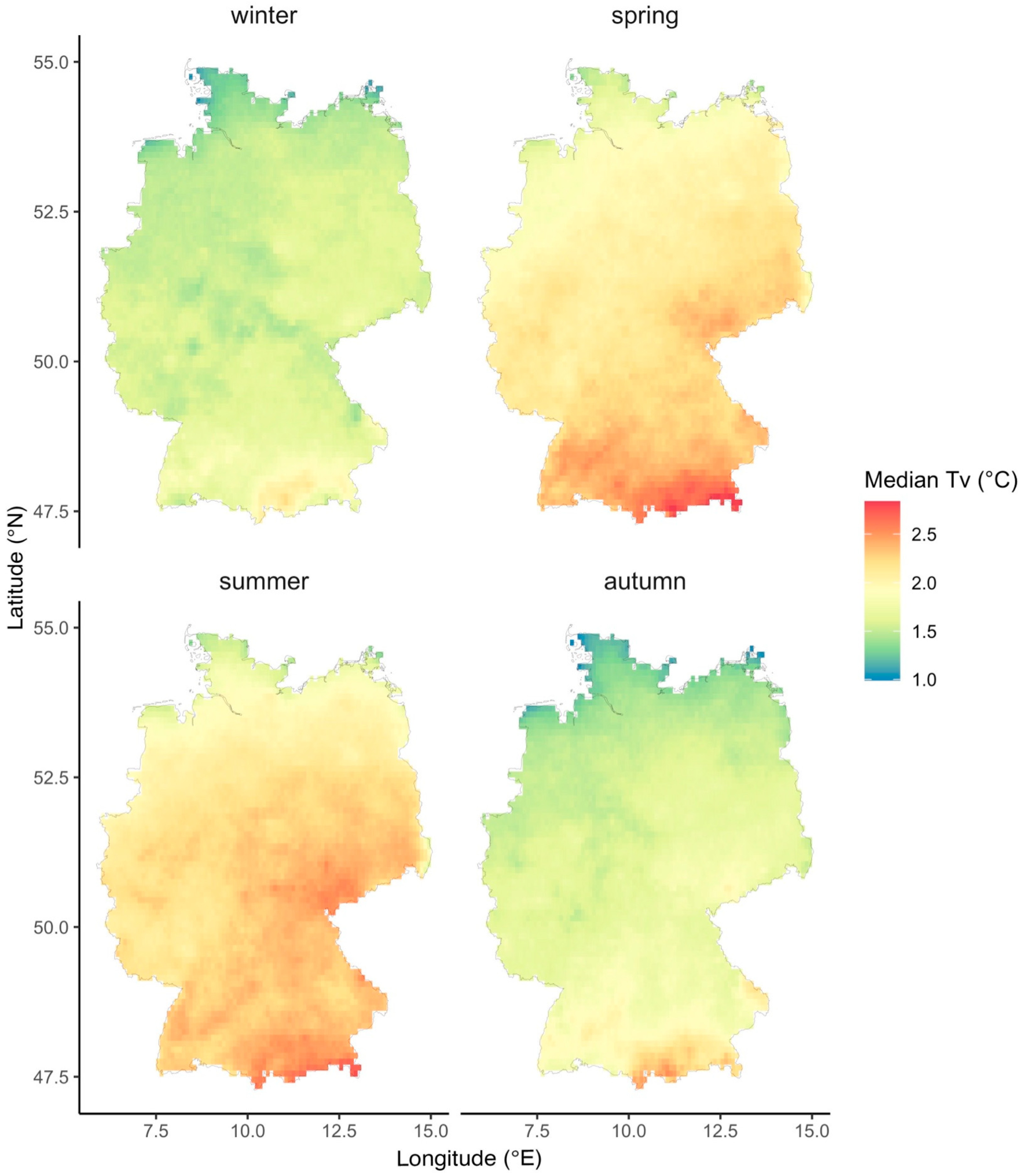
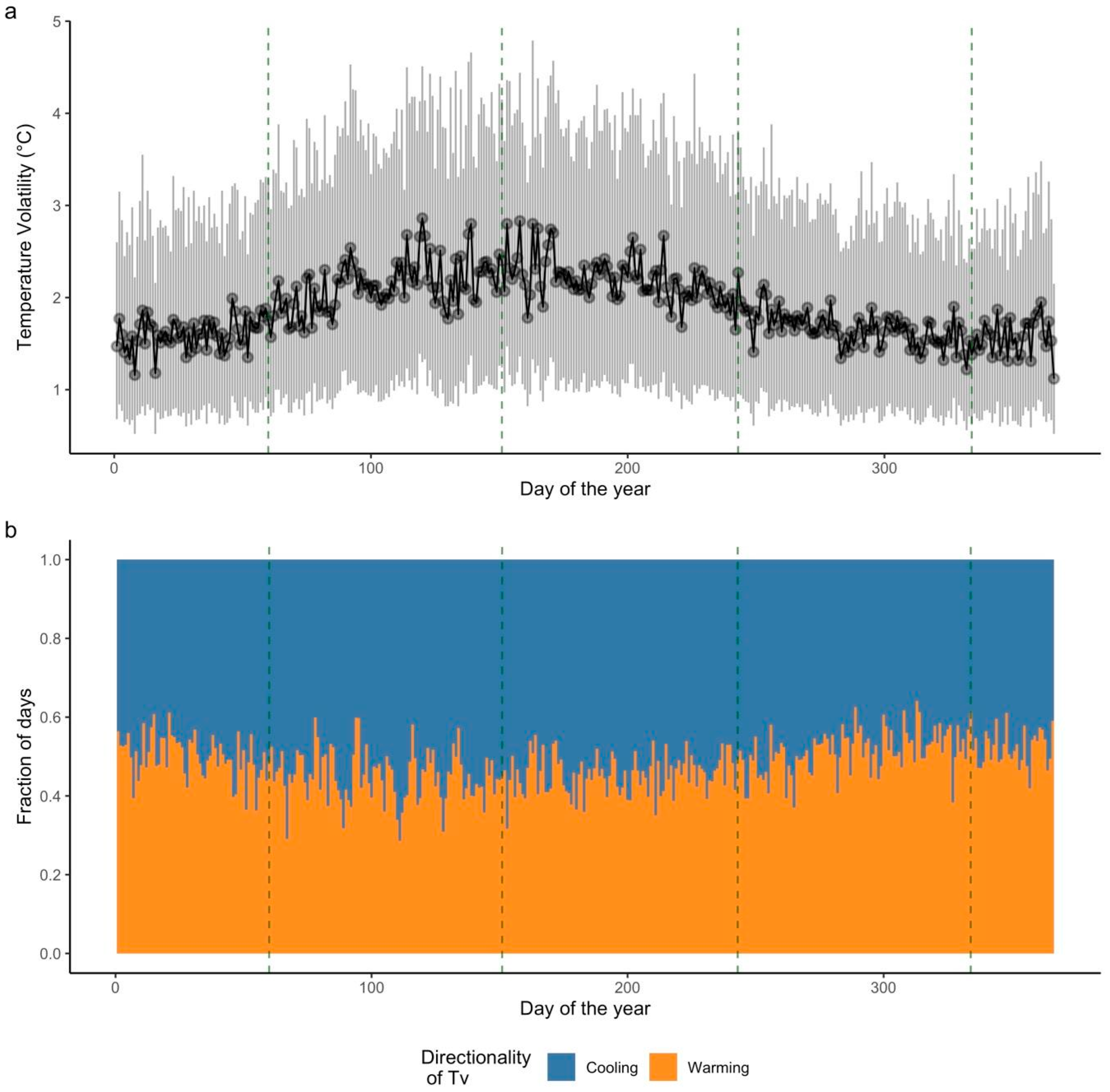


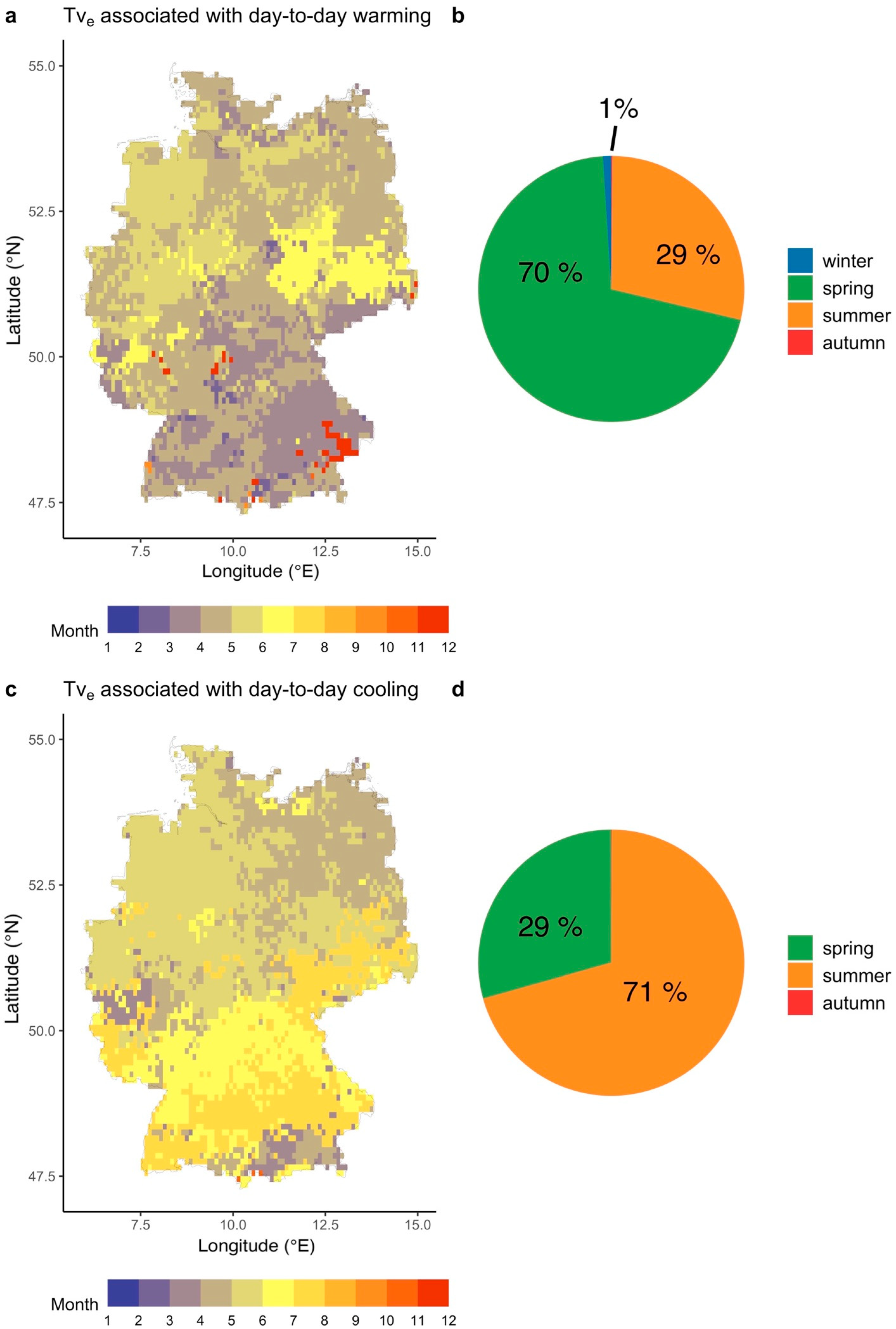

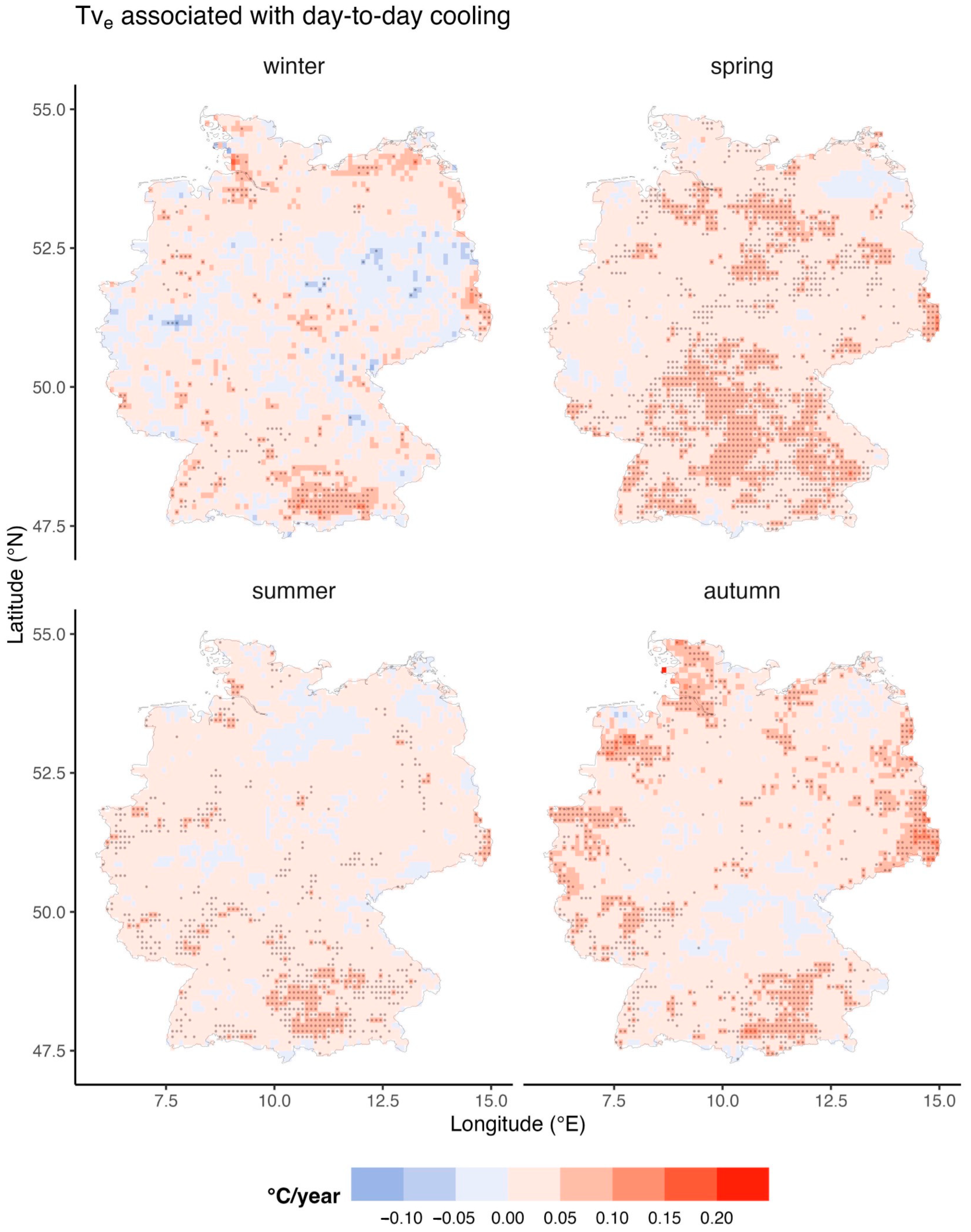
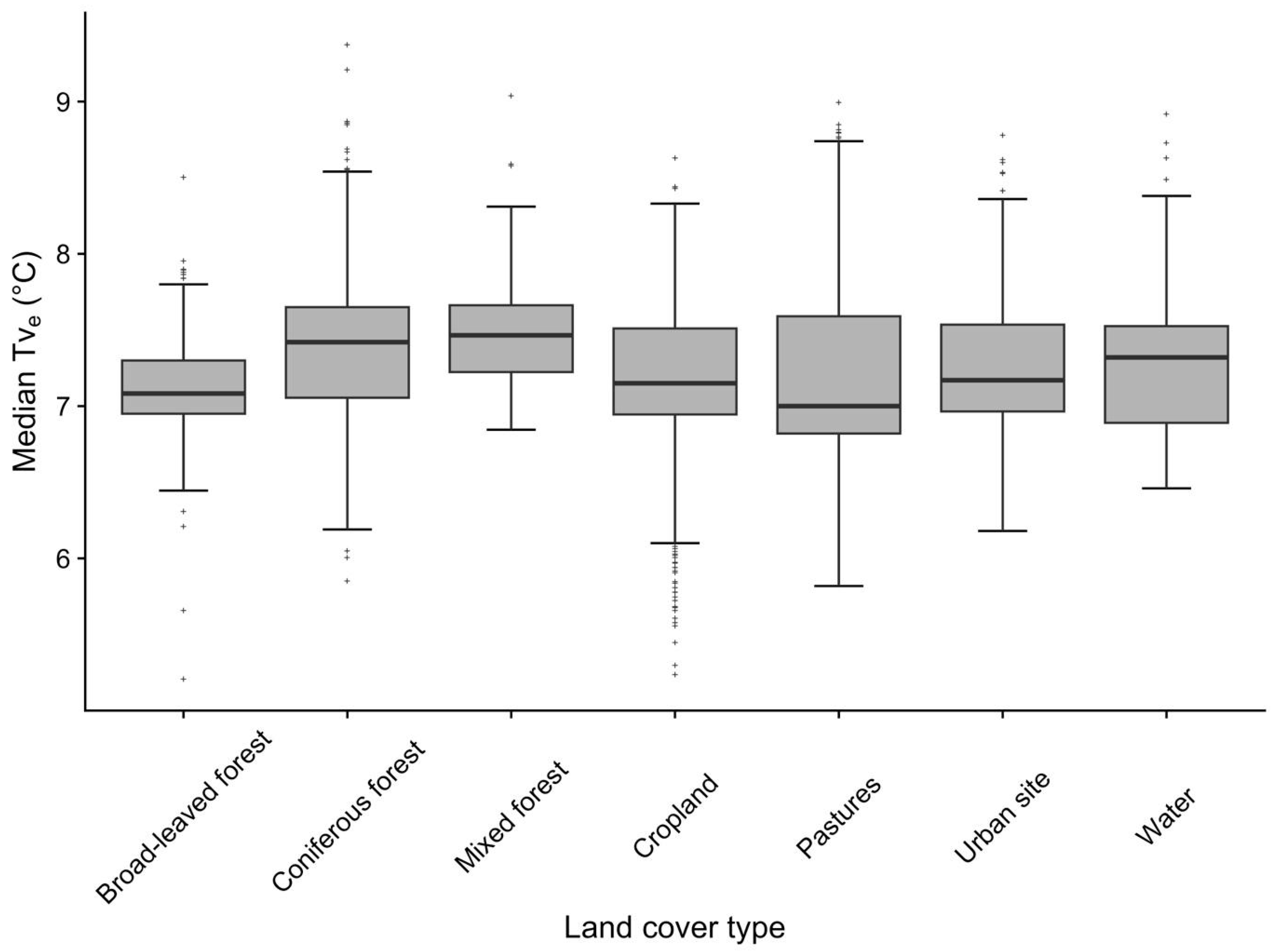
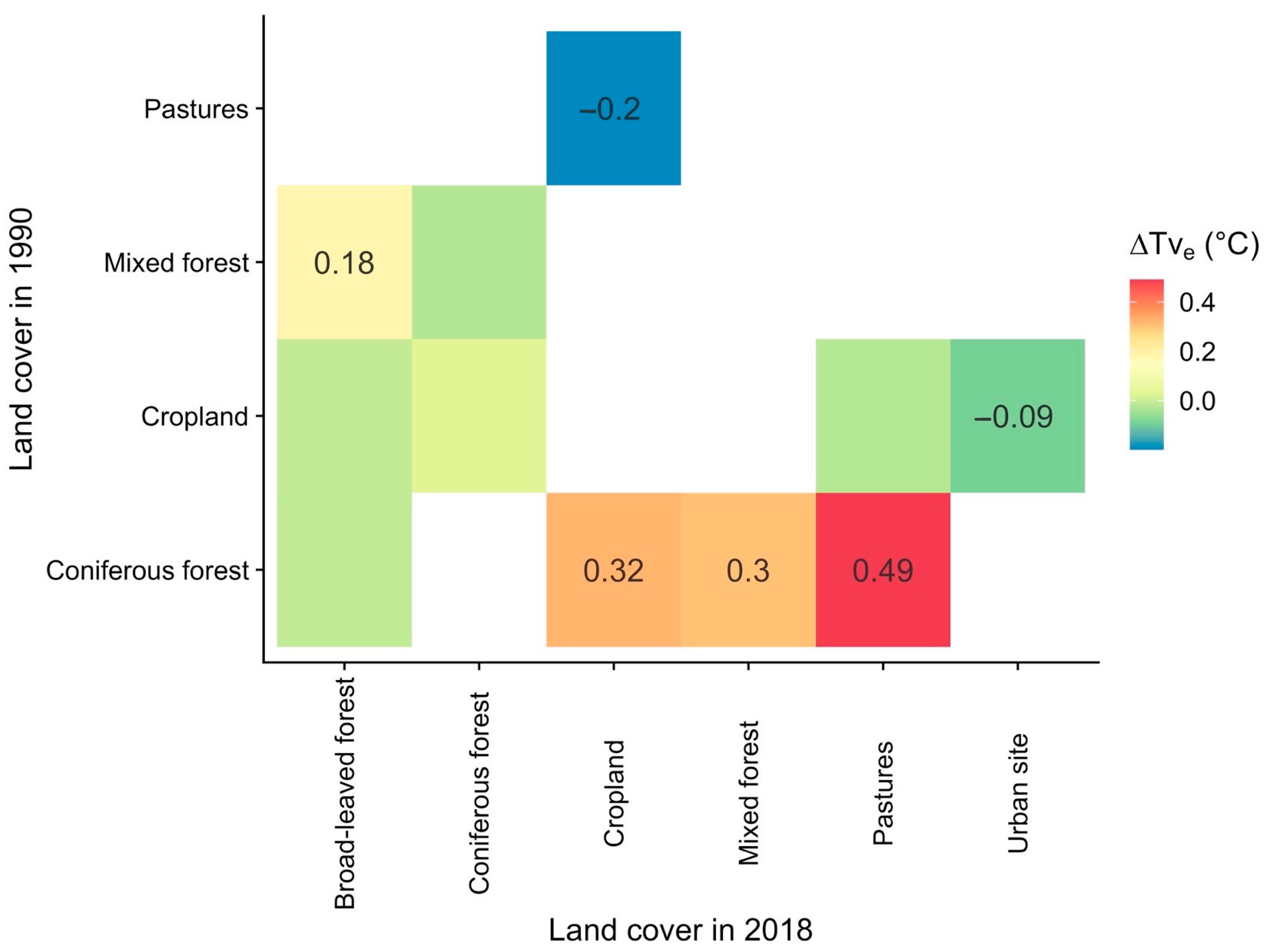
Disclaimer/Publisher’s Note: The statements, opinions and data contained in all publications are solely those of the individual author(s) and contributor(s) and not of MDPI and/or the editor(s). MDPI and/or the editor(s) disclaim responsibility for any injury to people or property resulting from any ideas, methods, instructions or products referred to in the content. |
© 2024 by the authors. Licensee MDPI, Basel, Switzerland. This article is an open access article distributed under the terms and conditions of the Creative Commons Attribution (CC BY) license (https://creativecommons.org/licenses/by/4.0/).
Share and Cite
Jordan, E.; Shekhar, A.; Gharun, M. Assessing the Volatility of Daily Maximum Temperature across Germany between 1990 and 2022. Atmosphere 2024, 15, 838. https://doi.org/10.3390/atmos15070838
Jordan E, Shekhar A, Gharun M. Assessing the Volatility of Daily Maximum Temperature across Germany between 1990 and 2022. Atmosphere. 2024; 15(7):838. https://doi.org/10.3390/atmos15070838
Chicago/Turabian StyleJordan, Elisa, Ankit Shekhar, and Mana Gharun. 2024. "Assessing the Volatility of Daily Maximum Temperature across Germany between 1990 and 2022" Atmosphere 15, no. 7: 838. https://doi.org/10.3390/atmos15070838
APA StyleJordan, E., Shekhar, A., & Gharun, M. (2024). Assessing the Volatility of Daily Maximum Temperature across Germany between 1990 and 2022. Atmosphere, 15(7), 838. https://doi.org/10.3390/atmos15070838








